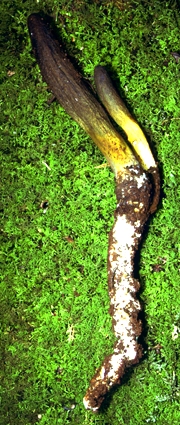
Cordyceps gunnii (Berk.) Berk.

Common name: Vegetable Caterpillar.
Description: Cordyceps gunnii forms club-shaped fruiting bodies projecting about 12 cm above the ground; the structure strongly resembles a base-ball bat. The club section of the fungus is 12 cm thick, about 58 cm long and is deep olive-green; the stem is yellow and about 1 cm thick. The fungus is apparently growing on the ground, but careful excavation shows that the stem passes underground and is attached to a mummified body of a caterpillar.
The spores are very difficult to find intact as they are thread-like and break apart into smaller sections very rapidly. These smaller sections function as fully viable spores and measure 37 × 13 µm; they are more or less cylindrical, smooth and colourless.
Substratum: Apparently growing on soil, the fungus is actually parasitic on the large caterpillars of hawk moths (Oxycanus spp.) which pupate underground. The fungus is sometimes quite prolific and has been seen in large troops where each fruiting structure grows from a single caterpillar.
Distribution: Known from all eastern mainland States and Tasmania.
Notes: These curious fungi are often destroyed before the collector realises what is being gathered. Usually, careful digging will find and extract the whole fungus with the caterpillar attached. In one Tasmanian example, the stem length from caterpillar to the green club-shaped fruiting body represented a length of over 30 cm. A related species, C. sinensis, is used in Chinese herbal medicine, but nothing is known of the pharmacological activity of the Australian species (see also C. hawkesii).

